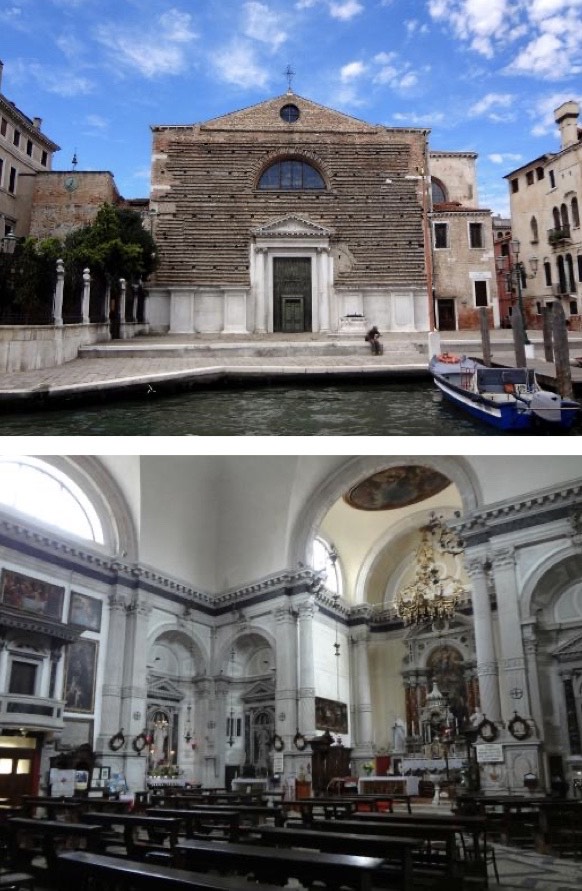The Church of San Marcuola, history and constructive events

The church of San Marcuola or church of Saints Ermagora and Fortunato is among the most characteristic monuments of the city: to an exterior devoid of any decoration and unfinished, is contrasted with a rich and opulent interior. Overlooking the Grand Canal, right in front of the famous Fontego dei Turchi, the church owes its singular name to the particular dialectal declension of the name Ermagora. The history of the church of San Marcuola has its roots in the distant Middle Ages: in fact, a consolidated historiographic tradition handed down the construction of a first building on the island of Lemeneo, between the ninth and tenth centuries. Around the small church, always according to the most ancient sources, a small community would have gathered, fleeing the fearsome invasion of the Lombards. The primitive nucleus of San Marcuola was, however, ruinously destroyed by the consequences of a violent earthquake: it was then decided to build a new sanctuary in its current geographical location, thanks to the economic contribution of the noble families of the Lupanizza and Memmo families. This new building was located longitudinally and parallel to the Grand Canal and dominated with its size a much more open and spacious field than the current one. But, substantially, the history of San Marcuola had a decisive turning point only towards the end of the seventeenth century when the architect Antonio Gaspari elaborated his personal project for the redevelopment of the building. The project, however, remained unfulfilled until the death of Gaspari, which occurred in 1730, the date from which another famous architect, Giorgio Massari, took over the direction of the works. The latter managed to complete the construction works of the internal part but, unfortunately, he was unable to complete those of the facade, which is still "unfinished" today. The last important date to remember is 1779, the year during which the church was consecrated for the last time by the patriarch Federico Maria Giovanelli.
The main works of art of the Church of San Marcuola
,_I.jpg)
Your visit to the Church of San Marcuola cannot certainly begin without a dutiful contemplative pause in the presence of its romantic and picturesque "unfinished" facade. A crude testimony of the complex constructive events of the sanctuary which allows, however, to still see "the ancient Romanesque soul of the church" breathe, and to imagine, with a little effort, the incomplete Baroque reconstruction.
The entrance inside the church, however, will satisfy your imaginative sacrifice and will also point out another unusual detail: the main passage of the sanctuary, in fact, was wanted by Massari on the south side and not on the west side, the one opposite at the altar, as is usually done. And this to respect the original plan of the building, but, at the same time, as evidenced by some drawings by the architect, preserved in the Correr Museum, to reproduce the same scenographic effect of the church of the Gesuati nobly projected on the Giudecca canal.
The church, which is characterized by a rectangular structure with a single nave with the presbytery obtained from a semicircular apse, is famous for a painting depicted on all the most important manuals of Art History: the Last Supper made by Tintoretto in 1547 and currently located on the left wall of the presbytery. The work, as evidenced by the inscription placed on the painting, was commissioned to the Venetian artist by Isepo Morandello, president of the Scuola del Sacramento, a small brotherhood that met right in the church of San Marcuola. On the opposite wall, another oil on canvas La lavanda dei piedi, a copy of the original painting by Tintoretto today at the Prado Museum, is a pendant to the picture. The famous Venetian artist and chronicler Mario Ridolfi in his life of Tintoretto written in 1642 openly praised the Last Supper and already testified to the "disappearance" of the Madrid painting.
But the church offers another interesting starting point for art lovers, the cycle of sculptures made starting from 1729 by Gaetano Susali, a pupil of the classicist sculptor Antonio Tarsia: Saints Giuseppe, Pietro Apostolo, Antonio da Padova, Giovanni Battista, Ermagora, Fortunato, Gaetano and others, will accompany you on your excursion to the church of San Marcuola.
"Listen" carefully to their words!
The church of San Marcuola is located in Salta Fontego 1762, in the Sestiere di Cannaregio 1762, and respects the following timetable:
- every day from 9:00 to 11:00 and from 17:30 to 19:00.










Lascia un commento